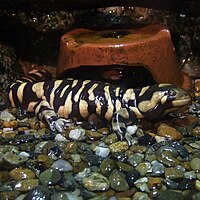
Abundance of invasive peacock bass increases with water residence time of reservoirs in southeastern Brazil
Sign Up to like & getrecommendations! Published in 2017 at "Hydrobiologia"
DOI: 10.1007/s10750-017-3467-x
Abstract: Neotropical freshwater ecosystems are experiencing a great expansion in the number of invasive species, which is especially alarming since this region harbours 30% of the world’s fish biodiversity with high levels of endemism. We aimed… read more here.
Keywords: residence time; water; abundance; peacock ... See more keywords

Can reductions in water residence time be used to disrupt seasonal stratification and control internal loading in a eutrophic monomictic lake?
Sign Up to like & getrecommendations! Published in 2021 at "Journal of environmental management"
DOI: 10.1016/j.jenvman.2021.114169
Abstract: Anthropogenic eutrophication caused by excess loading of nutrients, especially phosphorus (P), from catchments is a major cause of lake water quality degradation. The release of P from bed sediments to the water column, termed internal… read more here.
Keywords: water residence; residence time; water; internal loading ... See more keywords

Responses of morphology-based phytoplankton functional groups to spatial variation in two tropical reservoirs with long water-residence time
Sign Up to like & getrecommendations! Published in 2020 at "Inland Waters"
DOI: 10.1080/20442041.2020.1745007
Abstract: ABSTRACT The responses of phytoplankton to the spatial variation of 2 tropical reservoirs with long water-residence times was studied by means of morphology-based functional groups (MBFGs). The groups were compared among the pelagic, tributary, and… read more here.
Keywords: water residence; reservoirs long; long water; water ... See more keywords

Redfield Ratios in Inland Waters: Higher Biological Control of C:N:P Ratios in Tropical Semi-arid High Water Residence Time Lakes
Sign Up to like & getrecommendations! Published in 2017 at "Frontiers in Microbiology"
DOI: 10.3389/fmicb.2017.01505
Abstract: The canonical Redfield C:N:P ratio for algal biomass is often not achieved in inland waters due to higher C and N content and more variability when compared to the oceans. This has been attributed to… read more here.
Keywords: residence; residence time; water; inland waters ... See more keywords